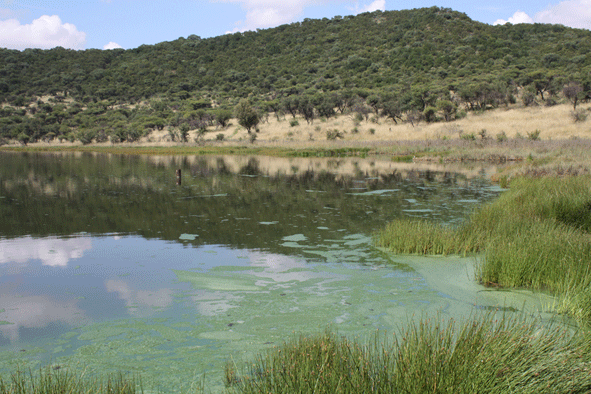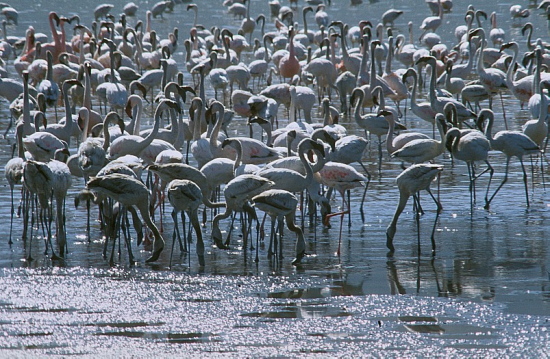Safe drinking water is a scarce resource in many developing countries. About 2.8 billion people, representing more than 40 per cent of the world’s population, live in river basins with some form of water scarcity. More than 1.2 billion of them live under conditions of physical water scarcity. Another 1.6 billion people live in areas of economic water scarcity, where human, institutional and financial capital limit access to water, even though water in nature is locally available to meet human demands. These conditions are prevalent in much of Southern Asia and sub-Saharan Africa. Symptoms include lack of, or underdeveloped, water infrastructure, high vulnerability to short- and long-term drought, and difficult access to reliable water supplies, especially for rural people.

Arthrospira fusiformis bloom in Lake Tswaing, South Africa
In Eastern and Southern Africa, cyanotoxins are reported to cause major problems in lakes and water reservoirs. Cyanotoxins are produced by cyanobacteria, or blue–green algae, living in the water. Nutrients such as nitrogen and phosphorus encourage the growth of the cyanobacteria. Cyanotoxins cause gastroenteritis, skin reactions and liver damage in humans. They also cause liver damage, nervous symptoms and skin lesions in many animal species, and lethal poisonings have been recorded in sheep, cattle, horses, pigs and dogs. The cyanotoxins also represent a serious threat to the wildlife in Southern Africa. Since the early 1990s, several mass mortalities of lesser flamingos in the alkaline lakes of Kenya and Tanzania have been reported with cyanotoxins as a possible cause. Acute cyanotoxin poisonings in humans are rare because water containing high concentrations of cyanobacteria has a foul smell and taste. Nevertheless, cyanotoxins represent a health risk to many people living in rural areas of Southern Africa due to chronic exposure to low levels of cyanotoxins in the drinking water. Only 21% of households in rural areas in this area have access to piped indoor water and the remaining households depend on what might be available in lakes, streams and wells. Moreover, water treatment plants in rural areas do not produce water of acceptable quality for domestic consumption.

Flamingos in an alkaline lake in East Africa
Primary objective: Develop a surveillance programme and cost-effective, reliable and easy-to-use diagnostic tools for cyanotoxins in water and wildlife, and transfer the technology and know-how to institutions in Southern Africa.
Secondary objectives:
1. Establishment of an epidemiological geodatabase to show the temporal and spatial distribution of cyanotoxins.
2. Validation of new and existing methods for monitoring and detection of cyanotoxins.
3. Development of novel antibody-based diagnostic tools.
4. Transfer of technology and know-how.
FRIMUF-project funded by Norwegian Research Council (NFR)
Timeframe: 3.5 year (2010-2013)